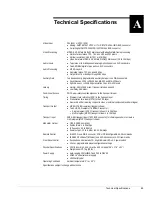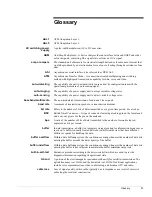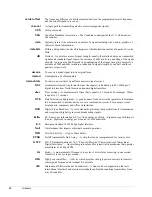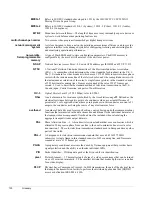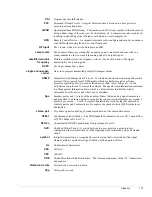
Glossary
99
IF
Intermediate Frequency—1. A frequency to which a signal wave is shifted locally as an
intermediate step in transmission or reception
2. The fixed frequency resulting from heterodyning the incoming signal with a signal from
a local oscillator.
IFL
Interfacility link— Typically refers to an interfacility link cable used to connect a
low-noise block (LNB) to an IRD. Often this IFL carries power from the IRD to the LNB.
IF looptest
A diagnostic, troubleshooting, or operational test procedure designed to test operate
satellite equipment by passing video and audio test signals through an encoder and
satellite modulator, looping the output of the modulator to the input of the IRD, and
monitoring the video and audio output of the IRD.
impedance
The total opposition of a device offers to the flow of alternating current. Measured in
Ohms and varies at different frequencies.
integrated
receiver /decoder
Within a satellite downlink system, a piece of equipment used to demodulate and decode a
transport stream.
IRD
See Integrated Receiver/Decoder.
kbps
Kilobits per second—A ratio of 1000 bits transmitted per second. For example, 10 Kbps is
equal to 10,000 bits transmitted per second.
kSps
Kilosample or kilosymbol per second—A ratio of 1000 samples or symbols transmitted
per second. For example, 10 kSps is equal to 10,000 samples or symbols transmitted per
second.
Ku-band
A portion of the electromagnetic spectrum in the 12GHz to 14GHz range. Used for
satellites, employing 14 GHz on the uplink and 11 GHz on the downlink in support of such
applications as broadcast TV for man -on-the street interviews and other situations
requiring a small, portable dish. Ku is also used in Direct Broadcast Satellite (DBS)
systems, or Direct Satellite System (DSS).
L-band
1. Portion of the electromagnetic spectrum commonly used in satellite applications, with
frequencies in the 390 MHz to 1550 MHz range. 2. For an IRD, the frequency received
from the LNB, existing in a range of 950 MHz to 2050 MHz.
LCD
Liquid crystal display—A display technology that uses liquid crystals to form displayed
characters.
LED
Light emitting diode—A display technology that uses a light emitting diode to form
displayed characters.
line resolution
The degree of sharpness of a displayed video image.
LNB
Low Noise Block —A combination low noise amplifier and local oscillator used in some
satellite downconverters.
LO
Local Oscillator—A device within a frequency converter that is used to reduce or increase
the frequency of the signal passed from the device input to output.
Mbps
Megabits per second—A ratio of 1,000,000 bits transmitted per second. For example,
15 Mbps is equal to 15,000,000 bits transmitted per second.
MCPC
See multi-channel-per-carrier.
mono channel
Referring to one audio output not contained in a stereo mix.
MPEG
Moving Picture Experts Group—A joint committee of the International Standards
Organization (ISO) and the International Electrotechnical Commission (IEC). 2. A series
of hardware and software standards designed to reduce the storage requirements of digital
video. 3. A compression scheme for full motion video.
Summary of Contents for TE3000
Page 10: ...viii Preface ...
Page 14: ...4 TE3000 Overview ...
Page 52: ...42 Using the Front Panel ...
Page 94: ...84 Maintenance and Software Upgrades ...
Page 96: ...86 Technical Specifications ...
Page 102: ...92 TE3000 PID Assignments ...
Page 112: ...102 Glossary ...

